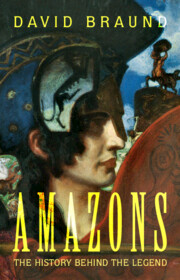Refine search
Actions for selected content:
12 results
Chapter 3 - Theos Apo Mēchanēs
- from Part I - Greek Tragedy and Mechanical Epiphany
-
- Book:
- Technologies of the Marvellous in Ancient Greek Religion
- Published online:
- 04 September 2025
- Print publication:
- 24 July 2025, pp 64-102
-
- Chapter
-
- You have access
- Open access
- HTML
- Export citation

Amazons
- The History Behind the Legend
-
- Published online:
- 26 March 2025
- Print publication:
- 24 April 2025
DEATH, RESURRECTION, AND REALISM IN EURIPIDES’ ALCESTIS
-
- Journal:
- Greece & Rome / Volume 72 / Issue 1 / April 2025
- Published online by Cambridge University Press:
- 18 March 2025, pp. 109-125
- Print publication:
- April 2025
-
- Article
-
- You have access
- Open access
- HTML
- Export citation
EURIPIDES, HERACLES 767
-
- Journal:
- The Classical Quarterly / Volume 74 / Issue 2 / December 2024
- Published online by Cambridge University Press:
- 09 May 2025, pp. 776-779
- Print publication:
- December 2024
-
- Article
- Export citation
6 - Philoctetes
-
- Book:
- Helping Friends and Harming Enemies
- Published online:
- 06 June 2024
- Print publication:
- 13 June 2024, pp 184-225
-
- Chapter
- Export citation
Chapter 4 - History peri physeos
-
- Book:
- Herodotus and the Presocratics
- Published online:
- 07 March 2024
- Print publication:
- 14 March 2024, pp 117-140
-
- Chapter
-
- You have access
- Open access
- HTML
- Export citation
14 - Religion
- from Part II - Contexts
-
-
- Book:
- The Cambridge Companion to Alexander the Great
- Published online:
- 04 January 2024
- Print publication:
- 18 January 2024, pp 226-242
-
- Chapter
- Export citation
THE PERSISTENT BONDS OF THE OIKOS IN EURIPIDES’ HERACLES
-
- Journal:
- The Classical Quarterly / Volume 72 / Issue 1 / May 2022
- Published online by Cambridge University Press:
- 11 April 2022, pp. 120-137
- Print publication:
- May 2022
-
- Article
-
- You have access
- Open access
- HTML
- Export citation
Chapter 3 - From Anger to Glory
-
- Book:
- The Hera of Zeus
- Published online:
- 19 January 2022
- Print publication:
- 27 January 2022, pp 232-317
-
- Chapter
- Export citation
The Literary Tradition of Destruction of Cities
- from Key Topics
-
- Book:
- The Cambridge Guide to Homer
- Published online:
- 22 February 2020
- Print publication:
- 05 March 2020, pp 322-324
-
- Chapter
- Export citation
15 - Was There an Interest in Literary Culture in the Great Oasis? Some Answers
- from Part IV - An Oasis Culture?
-
-
- Book:
- The Great Oasis of Egypt
- Published online:
- 12 July 2019
- Print publication:
- 18 July 2019, pp 269-280
-
- Chapter
- Export citation
Part IV - An Oasis Culture?
-
- Book:
- The Great Oasis of Egypt
- Published online:
- 12 July 2019
- Print publication:
- 18 July 2019, pp 217-296
-
- Chapter
- Export citation
